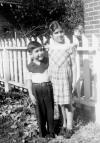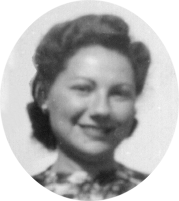|
By Susan M. Rogers with Michael-David BenDor
My brother and I were very little
kids on the occasion of our first visit to Aunt Bea’s house. It was
during a summer vacation in the late 1940s, when we
 arrived
on her tree-lined street in Brooklyn. We had driven with our parents from
Denver, Colorado, to New York City, the first of a series of those summer
trips “to visit the relatives." Highlights of the earliest were
seeing television for the first time at Uncle Arthur’s, and attending a
backyard barbecue at Aunt Bea’s. arrived
on her tree-lined street in Brooklyn. We had driven with our parents from
Denver, Colorado, to New York City, the first of a series of those summer
trips “to visit the relatives." Highlights of the earliest were
seeing television for the first time at Uncle Arthur’s, and attending a
backyard barbecue at Aunt Bea’s.
“There were lots and lots of family people walking around,” said
Michael-David, whose only other memory of that event was their garage,
which held great interest for him at the time. My own memories of long
ago family events tend to center on food, and that barbecue was
unforgettable.
New York, New York
The
way people ate in New York City in those days was a real an eye-opener for
us. Scrambled eggs with ketchup for breakfast and a piece of cherry pie
was how things were done, at least sometimes, at the home of Arthur and
Ruth Rogers. And, more than a half century later, I still remember being
stunned by the backyard barbecue menu at Sidney and Bea Rubenstein’s: hot
dogs were followed on the grill by hamburgers, an ample feast right there.
But then, out came steaks!
‘Queen Bee around the Operation’
The balance of our contribution to
Aunt Bea’s 95th birthday memory book is based on conversations six years
ago about our family history. Fortunately, I found my notes on the
various phone interviews that came to mind. All from September,
1997, these include 'new' material, which is to say, information not used
on our family history web page, and now therefore, doubly precious.
Setting the scene
Morris Rubenstein had been
confined to a wheel chair for over a dozen years by the time Aunt Bea
arrived on the scene as the girlfriend of his oldest son. After Morris
lost both his legs, life became much more difficult for his wife, Esther.
She was an exceptional woman, having gone to a business school, which was
an unusual accomplishment in those days. With four sons, she had her
hands full in running the household, and she divided up what chores she
could among them. Nobody begrudged her taking time for herself for
self-renewal, in order that she more easily shoulder her burden. Hanging
around the kitchen and cooking were not favorite activities. Indeed,
Morris’s youngest sister, Dora, would be summoned to the rescue when it
was Esther’s turn to prepare the Seder meal for the family of their first
cousin, Esther Chasman. Dora told me that her sister-in-law Esther’s idea
of spaghetti “was pouring ketchup on some noodles.”
Morris and Bea
While Morris was much beloved and
often in the company of visiting family; the Karbens would drop in without
knocking, his niece, Shirley, told me. Nonetheless, solitude was
Morris's most frequent companion. Then Sidney began keeping company with
Bea Glazer. Sidney brought her to meet the family, and by and by, she
began to visit Morris and would even do a little cooking for him. She was
a superb cook and made perfect blintzes, which delighted him no end.
According to Phil Karben, “she was the Queen Bea around the operation.”
Pen pals
Confined to his wheelchair in
their house on Essex Street, Morris would occupy himself with weaving on a
small handloom or sewing. While he worked away there, in solitude, he
would daydream. After Bea came into the lives of the Rubenstein household
-- at the time in her life when she looked her loveliest -- Morris, quite
understandably, found himself with a truly delightful subject. He made
her a pen pal of sorts, composing letters on occasion, and on her
engagement to Sidney, an ode [below] that she was ultimately persuaded to
translate for our family history web page. Aunt Bea has my undying
gratitude for providing this insight into Morris, whom all his
grandchildren would have loved
to know; he died two years before I was born. himself with weaving on a
small handloom or sewing. While he worked away there, in solitude, he
would daydream. After Bea came into the lives of the Rubenstein household
-- at the time in her life when she looked her loveliest -- Morris, quite
understandably, found himself with a truly delightful subject. He made
her a pen pal of sorts, composing letters on occasion, and on her
engagement to Sidney, an ode [below] that she was ultimately persuaded to
translate for our family history web page. Aunt Bea has my undying
gratitude for providing this insight into Morris, whom all his
grandchildren would have loved
to know; he died two years before I was born.
In happiness I sat at
the machine and watched the needle move to and fro. Suddenly I fell into
deep thought -- memories, happenings from bygone days, came and went
without measure. As I sat in this reverie, it seemed I heard a voice --
a voice clear and distinct said sweet and plain, "Morris, Morris, say a
prayer to God -- you will now definitely be blessed." I obeyed very
happily and hoped my prayer will be heard above. I beseeched for you,
Sidney and Bea, that you shall be blessed with health, happiness and
riches, and that each of you in your own way, shall be proud of each
other -- and we, your parents, will be honored and proud to see you as
bride and groom under the chupah in the very near future, where
you will be proclaimed as husband and wife, and the guests--friends and
relatives -- will wish mazel tov to the happy bride and groom.
On February 16, 1936, Bea Glazer and Sidney Rubenstein were married.
The Karben factors
Morris Rubenstein was 15 years
older than Dora, his youngest sister, and Sidney was 13 years older than
Phil, the first of Dora’s three sons. Dora’s family frequented Morris’s
house, and Phil remembers being “extremely fond of Sidney and Bea,” whom
he said he “knew better, and saw more often, than Larry and Tess,” our
parents. Bea’s family, Phil observed, were “a very, very close
family. Bea and her siblings meant so much to each other.”
Sidney’s ‘little sister’
Sidney was eleven
years older than Shirley Karben. “I was [like] his sister; I grew up in
that house,” she told me three years before her death, in 2000. Sidney
and she were “very good friends,” she said, remembering the last time they
were together, in his drug store. It was just before he set off for
Houston, Texas, to have an operation on his heart. “He wanted me to stay
a little longer,” Shirley said, “It was as though I’m not going to see
him again.” Sidney volunteered to Shirley that he had “everything up to
date," regarding the insurance and the house. “He didn’t want me to go
home,” Shirley said.
Joint
appreciation
Thirty-two years
after Sidney’s death, Shirley told me that Aunt Bea had said to her at the
time, in 1965, that the two of them [Shirley and Bea] were “the only ones
who appreciated what we lost.”
 |